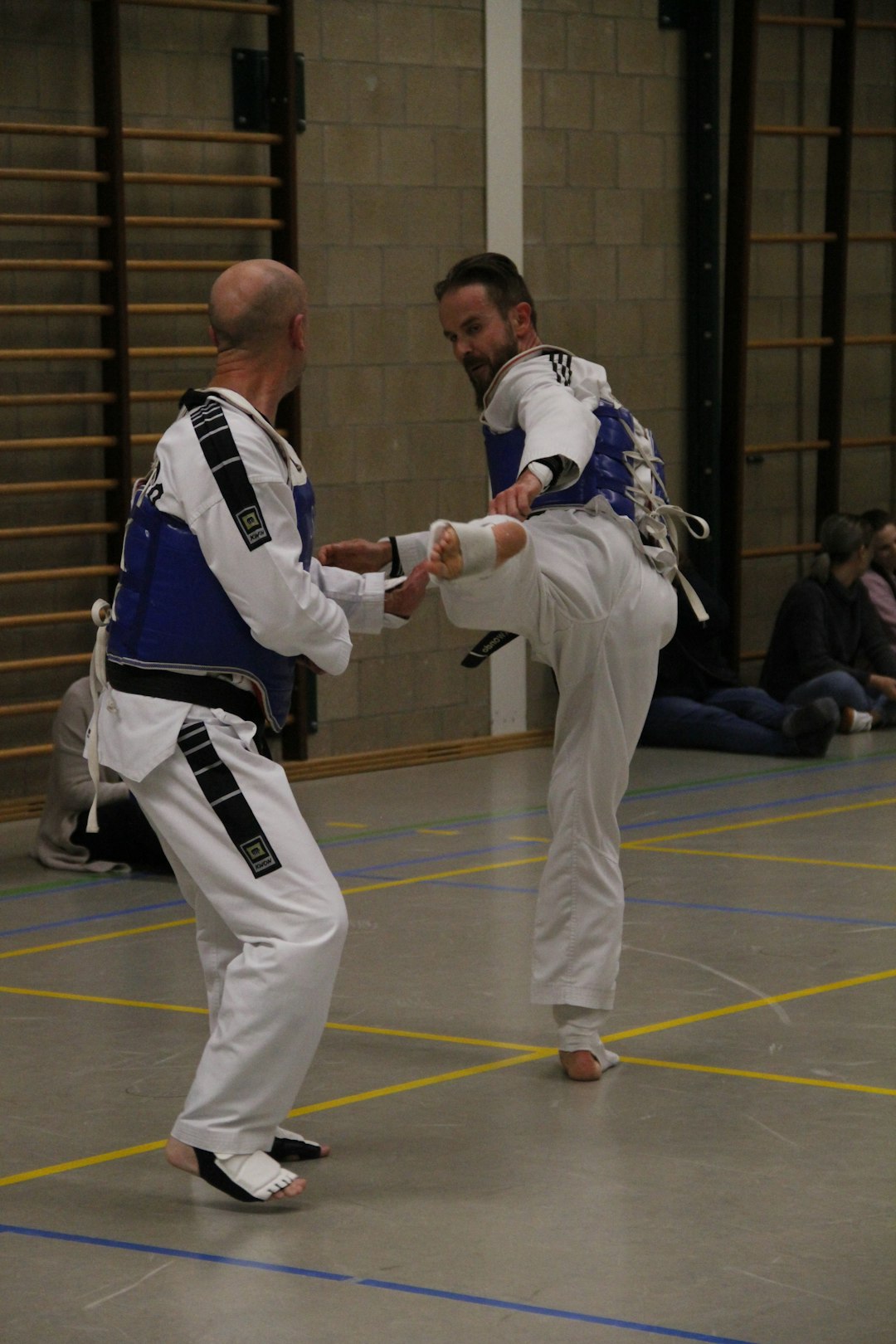Creating a dedicated home dojo for karate can significantly enhance your practice by providing a focused and quality training environment. To set up an effective space, ensure it's at least 10 feet by 10 feet to accommodate full-range karate movements like kata and kumite. Essential equipment includes a well-fitting karate suit, such as the Mundart Karate Gi, for both discipline and mobility, along with a high-quality mat to protect against injuries during exercises. A wall mirror is invaluable for checking your form, especially for beginners. Your training area should be free from distractions with a smooth, even floor surface that supports safety and performance. Supplement your setup with a wall clock for timing drills and storage solutions for your gear to keep your practice efficient and focused. For advanced training, consider adding a heavy bag or focus mitts to improve striking skills. While a karate suit isn't mandatory for solo home training, it can enhance the experience and ensure proper technique. Regular, shorter training sessions are recommended over less frequent but longer ones for consistent progress and discipline maintenance in your karate regimen.
Explore the art of Shotokan Karate from your living room with our comprehensive guide on training at home. Whether you’re a beginner or an experienced practitioner, this article outlines essential steps to set up your home training space, master karate fundamentals through self-paced drills, and advance your technique with tactical exercises. From understanding the importance of your karate suit—or Gi—to building strength and endurance, each section provides practical advice and resources for a well-rounded practice. Discover how to safely create a training area, progressively enhance your techniques with resistance training, and refine your movements through video analysis. This guide empowers you to develop balance, coordination, and powerful strikes, all within the comfort of your home.
- Setting Up Your Home Karate Training Space
- – Essential Equipment: Understanding Your Karate Suit (Gi) and Other Necessities
- – Creating a Safe and Effective Practice Area in Your Home
- – Tips for Maximizing Limited Space for Solo Training
Setting Up Your Home Karate Training Space

When training karate at home, having a dedicated space can significantly enhance your practice. To begin setting up your home dojo, consider the area’s dimensions and ensure it allows for enough movement, particularly for kata performance and kumite drills. A clearance of at least 10 feet by 10 feet is ideal, though any space that offers a few unobstructed square meters will suffice. Next, outfit this space with the appropriate gear, including a karate suit, also known as a gi. Investing in a quality mat for floor exercises like kata practice or basic blocks can also protect your joints and provide cushioning against falls during more advanced techniques. A mirror is beneficial for checking form, particularly for newcomers who are learning the correct postures and stances. Ensure your training space is free from distractions and has a surface that won’t compromise your performance; a smooth, even floor is best. Do you have a space at home that can be transformed into a karate training area? If so, assess its size and layout to optimize it for your practice. Is your chosen location safe and conducive to the various movements in karate? If it’s clear and level, with ample space for all your exercises, you’re ready to start your home training. Remember to also include a wall clock to keep track of timing for drills, and perhaps a small shelf or rack for storing your gi and any other necessary equipment conveniently.
– Essential Equipment: Understanding Your Karate Suit (Gi) and Other Necessities

When training karate at home, having the right equipment is crucial for an effective practice session. A fundamental piece of equipment is your karate suit, commonly known as a Gi. The Gi not only provides a traditional and respectful attire that aligns with the discipline of karate but also allows you to execute techniques clearly, enabling both you and any observer to see your form and movements accurately. It’s essential to choose a Gi that fits well; it should be neither too tight nor too loose. Are the sleeves and pants of your Gi functional for your practice? They should allow for a full range of motion without being restrictive. Additionally, while practicing at home, you’ll want a surface that offers some give, like a properly matted area or a soft floor mat, to protect you from injury when performing techniques such as kicks and blocks. Do you have a safe space free from furniture or hazards? Ensure your training area is clear and has enough room for you to move freely without risk of tripping or bumping into objects. A wall mirror can also be beneficial, as it helps you monitor your form and posture, ensuring that your stances and techniques are performed correctly. What about a heavy bag or focus mitts for striking? These can be excellent for practicing punching and kicking techniques, providing resistance to help strengthen your strikes. Are you equipped with a reliable stopwatch or timer for practicing kihon (basic techniques) and kata (forms)? These tools will help keep your practice sessions structured and focused. By gathering these essential items, you’ll lay the foundation for a disciplined and effective karate training regimen at home.
– Creating a Safe and Effective Practice Area in Your Home

To begin training karate at home, it’s crucial to establish a space that is both safe and conducive to effective practice. Start by choosing an area in your home that offers enough open space to move freely without obstruction. Ensure this area is free from potential hazards like sharp furniture or breakable objects that could cause injury during practice. Investing in a quality karate mats will significantly enhance your safety; these mats can absorb the impact of falls and provide a stable surface for performing techniques. Additionally, consider the type of karate suit you’ll be using, as some suits may require more padding than others. Are karate mats necessary for every type of training? Absolutely, as they offer cushioning against hard floors and protect your joints during practice, especially when executing strikes or performing groundwork. Do they contribute to a more authentic training experience? They do, by closely mimicking the feel of a professional dojo while also providing the safety needed for home practice. By setting up your area with these considerations in mind, you can create an environment that allows you to train karate effectively and safely at home.
– Tips for Maximizing Limited Space for Solo Training

When training karate at home, especially when space is limited, it’s crucial to optimize the area you have available for effective practice. To begin with, select a clear, unobstructed space that allows for free movement in all directions. Ensure this space is cushioned adequately to prevent injury from falls or kicks; mats designed specifically for martial arts are ideal. Next, consider how to organize the space to simulate a dojo environment. Can you position yourself where you can practice both offense and defense with minimal repositioning? If so, this will maximize your training efficiency. Additionally, make use of walls and furniture for kata practice, where you can focus on precision and form by using them as imaginary opponents. When practicing stances, remember that less space can actually be beneficial; it forces you to perfect close-quarters techniques, which are essential in real combat scenarios.
In terms of equipment, a karate suit, or gi, is not strictly necessary for solo training at home, but it can help you get into the right mindset and protect your clothing. If you choose to wear one, ensure it fits well to avoid tripping or hindering your movements. A mirror can also be an invaluable tool for self-reflection, allowing you to check your stances and form. Lastly, remember that consistency is key; even short, focused training sessions can be more beneficial than sporadic longer ones. How often do you plan to train? Regular, shorter sessions will lead to gradual improvement and help you stay disciplined in your practice.
In conclusion, training karate at home is a rewarding endeavor that requires dedication and some initial setup. By equipping yourself with a quality karate suit—commonly known as a Gi—and designating a dedicated space in your home that is both safe and conducive to practice, you can effectively train solo. Utilize the available space efficiently, focusing on the movements and techniques rather than the space constraints. With the guidance provided in this article, from understanding the essentials of your Gi to creating an optimal training environment, you’re now equipped to embark on a martial arts journey right within your own four walls. Whether you’re a beginner or looking to refine your skills, consistent practice and mindful adaptation of traditional techniques to home training will bring you closer to mastering this ancient discipline.
